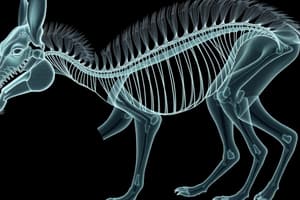Podcast
Questions and Answers
What is the level of organisation found in Porifera?
What is the level of organisation found in Porifera?
- Cellular level of organisation (correct)
- Organ level of organisation
- Tissue level of organisation
- Organ system level of organisation
What is the characteristic of a closed circulatory system?
What is the characteristic of a closed circulatory system?
- Blood is circulated through arteries, veins and capillaries (correct)
- Cells and tissue directly receive the blood pumping out of the heart
- Presence of a coelom
- Absence of a coelom
What is the term for the body cavity between the body wall and gut wall, lined by mesoderm?
What is the term for the body cavity between the body wall and gut wall, lined by mesoderm?
- Pseudocoelom
- Gastrovascular cavity
- Coelom (correct)
- Haemocoel
Which type of symmetry is found in Echinoderms?
Which type of symmetry is found in Echinoderms?
Which phylum is characterized by the presence of notochord?
Which phylum is characterized by the presence of notochord?
What is the characteristic of a diploblastic embryo?
What is the characteristic of a diploblastic embryo?
What is the term for the level of organisation in which tissues are grouped together to form an organ?
What is the term for the level of organisation in which tissues are grouped together to form an organ?
What is the characteristic of a pseudocoelomate?
What is the characteristic of a pseudocoelomate?
Which phylum has external fertilization and indirect development?
Which phylum has external fertilization and indirect development?
Which phylum is characterized by the presence of flame cells?
Which phylum is characterized by the presence of flame cells?
Which phylum has a metamerically segmented body?
Which phylum has a metamerically segmented body?
Which phylum has a complete alimentary canal with a muscular pharynx?
Which phylum has a complete alimentary canal with a muscular pharynx?
Which phylum has bioluminescence?
Which phylum has bioluminescence?
Which phylum has a closed circulatory system?
Which phylum has a closed circulatory system?
Which phylum has radially symmetrical body?
Which phylum has radially symmetrical body?
Which phylum has parapodia for swimming?
Which phylum has parapodia for swimming?
Study Notes
Classification of Animals
- Animals are classified based on common fundamental features such as cellular arrangement, body symmetry, presence or absence of coelom, and specific features of digestive, circulatory, and reproductive systems.
Levels of Organisation
- Cellular level: cells arranged as loose aggregates, found in Porifera (sponges).
- Tissue level: cells performing the same function form tissues, found in coelenterates.
- Organ level: tissues grouped together to form an organ, which performs a particular function, e.g. Platyhelminthes.
- Organ system level: a few organs coordinatively perform a certain physiological function, e.g. Annelids, Arthropods, Molluscs, Echinoderms, and Chordates.
Circulatory Systems
- Open circulatory system: cells and tissue directly receive the blood pumping out of the heart.
- Closed circulatory system: blood is circulated through arteries, veins, and capillaries.
Body Symmetry
- Asymmetrical: no line of symmetry in the body, e.g. sponges.
- Radial symmetry: any plane passing through the centre divides the body into two symmetrical halves, e.g. coelenterates, ctenophores.
- Bilateral symmetry: a plane divides the body into symmetrical left and right halves, e.g. annelids, arthropods, etc. Echinoderms exhibit radial as well as bilateral symmetry at different stages of their life.
Body Cavity
- Coelom: body cavity between the body wall and gut wall, lined by mesoderm.
- Acoelomates: body cavity is absent, e.g. Platyhelminthes.
- Pseudocoelomates: mesoderm is present as scattered pouches, e.g. Aschelminthes.
- Coelomates: having coelom (body cavity), e.g. from Annelida to Chordata.
Embryonic Development
- Diploblastic: embryo with two germinal layers called external ectoderm and internal endoderm, e.g. Porifera, Cnidaria.
- Triploblastic: embryo with three germinal layers, mesoderm between ectoderm and endoderm, e.g. Platyhelminthes to Chordates.
Body Segmentation
- Metameric segmentation: body shows repeating parts, e.g. earthworm's body.
Chordates
- Animals with notochord are called chordates, e.g. from Chordata.
- Animals without notochord are called non-chordates, e.g. from Porifera to Echinodermata.
Phylum Ctenophora
- Radially symmetrical, diploblastic, and acoelomate
- Eight rows of ciliated comb plates present externally
- Digestion occurs both extracellularly and intracellularly
- Bioluminescence is present
- Hermaphroditic, with external fertilization and indirect development
Phylum Platyhelminthes (Flatworms)
- Mostly endoparasites, dorsoventrally flattened body
- Triploblastic, bilaterally symmetrical, and acoelomate
- Hooks and suckers are present in parasites
- Flame cells help in osmoregulation and excretion
- Hermaphroditic or monoecious, with internal fertilization and indirect development
- Planaria can regenerate
Phylum Aschelminthes
- Free-living or parasitic, aquatic or terrestrial
- Round body in cross-section, bilaterally symmetrical, and triploblastic
- Pseudocoelomate with organ system organization
- Alimentary canal is complete and has a muscular pharynx
- Dioecious, with females longer than males
- Internal fertilization with direct or indirect development
Phylum Annelida
- Bilaterally symmetrical, triploblastic, and coelomate
- Metamerically segmented
- Longitudinal and circular muscles help in locomotion
- Nereis has appendages called parapodia for swimming
- Closed circulatory system
- Nephridia are present for osmoregulation and excretion
- Paired ganglia are connected to a double ventral nerve cord by lateral nerves
- Sexual reproduction, with dioecious, monoecious, and hermaphroditic species
Studying That Suits You
Use AI to generate personalized quizzes and flashcards to suit your learning preferences.
Description
This quiz covers the classification of animals based on their fundamental features, including cellular arrangement, symmetry, and presence of coelom, as well as specific features of digestive, circulatory, and reproductive systems.




